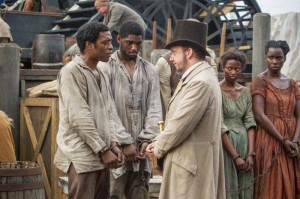
Below The Line Screening Series members filled the Linwood Dunn theater for a presentation of 12 Years A Slave, Thursday, Dec. 12. The film is based on Solomon Northup’s true story of being kidnapped, sold into slavery and rescued 12 years later after meeting a Canadian abolitionist by chance. Steve McQueen directed the film intent on honesty and exposure. “For me there was a hole in the canon of cinema. I didn’t see that history, at all, on screen,” said McQueen.
A Q&A session following the film allowed McQueen, editor Joe Walker, re-recording mixer Leslie Shatz, re-recording mixer and supervising sound editor Ryan Collins and makeup department head, designer and special makeup effects artist Ma Kalaadevi Ananda to recall their experience making 12 Years A Slave.
As McQueen entered the theater he received a standing ovation, but when he had the chance, he directed the praise to his team, saying, “I’m very passionate about it being a collaboration, about it being a family, about it being a team. I’m nothing without a good team.” Many of McQueen’s teammates worked on his previous films, including Walker, editor of both Hunger (2008) and Shame (2011).
Walker began the editing process in Louisiana during production. “I think being there was really important because you felt some weight of the story there,” said Walker. From moments of punishment by whip to expository glimpses at the Louisiana setting, Walker stressed the use of time as storyteller in his editing process. “Steve had a very strong idea about how he wanted to show Solomon hanging. We knew it was going to need time. We wanted it to be awkward and deeply uncomfortable to the point where hopefully the audience is just wanting to get up and stop it,” said Walker. “How do you get there? You don’t get there by going there slow. You get there by skipping bits of time and playing with time. These are the things we were concerned about in the cutting room.”
“Louisiana was the first foreign country I ever went to,” joked Shatz. The roar of Cicadas gave score to the setting of Spanish moss and bayou land, a sonic world foreign to Shatz and the sound team. Although unfamiliar, Shatz was excited to explore the landscape, saying, “Here is a film that is actually made in Louisiana about Louisiana, which is a treat because we got to take those sounds that are indigenous to that area and actually use them, make them a part of the piece.” Shatz explained the presence of Cicadas as a constant natural underscore that feels peaceful most of the time though, with the right change in Hans Zimmer’s otherwise transparent score, can take an equal turn.
Shatz and sound team were asked, as were all creative departments, to create honest presentations of uncomfortable situations such as whippings and beatings. Regarding any difficulty audiences may have sitting through such an unfiltered presentation, McQueen said, “If you don’t look at something, you are participating in avoidance and allowing that sort of blindness and intolerance to continue.” Collins added by expressing the importance of staying true to Solomon’s story by utilizing his sonic environment and experiences to place the audience in his reality.
Providing the special makeup effects in the Louisiana climate proved challenging to Ananda. Scars and fresh wounds were needed to present the truth regarding the abuse slaves faced in pre-Civil War United States. Keeping the scars and wounds on the backs of the actors wasn’t easy. “I called everyone who I knew lived in New Orleans and had done makeup to see if they knew any secrets they’d share with me. I had a wonderful team of New Orleans makeup artists who had worked on many films. There was nothing I could put on the skin that would not be sweated off,” said Ananda. “I even used tattoo color, which you can go swimming in and it won’t come off, but it would come off.” Ananda shared in the commitment to providing a realistic depiction of Solomon’s story. “I wanted you to see Solomon, not makeup. So, I always kept a lighter hand in that respect,” she said.
The unfiltered adaptation of Northup’s true story is currently in theaters and has received seven 2014 Golden Globe nominations.





